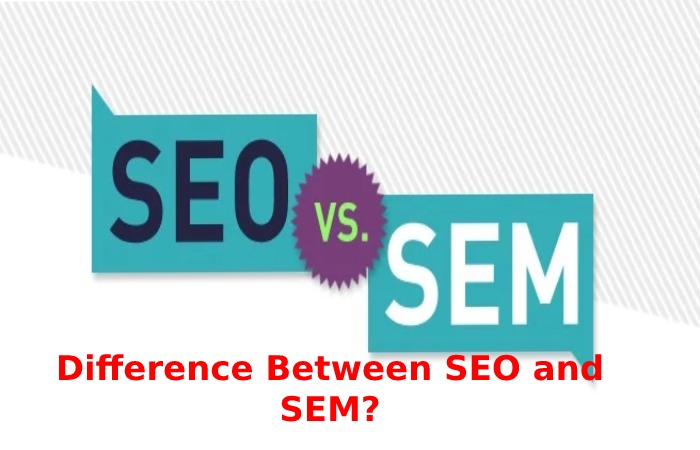Table of Contents
Introduction
SEM is a form of marketing promoting a website on search engine results pages. By ensuring your website ranks high in search results, SEM will help you generate more traffic and gain more customers.
Difference Between SEO and SEM?

It is difficult to avoid ambiguity when discussing the differences between SEO (Search Engine Optimization) and SEM. Getting your website to the top of the search engine results page can include organic promotion and paid advertising such as PPC (Pay Per Click) ads. Search engine optimization or SEO has always been considered an organic promotion, while opinions about SEM have changed over time.
In the beginning, the term SEM included both paid and organic strategies. In this case, SEO appears as part of SEM. However, marketers are increasingly using the phrase “search engine marketing” only for paid activities, making SEM and SEO two different categories. In this article, we will use the word SEM only to avoid confusion to refer to paid search advertising.
Why is SEM Important?
Along with SEO, SEM helps your business rank at the top of search results on Google, Bing, and other search engines. The first page of search results gets more than 71% of all clicks.
Search engine marketing is becoming increasingly significant as a traffic generation channel. While click-through rates from organic search results have dropped 13% in the first quarter of 2019, SEM soared 75% in the same period.
Improved yet, audiences are loyal to SEM. 75% of people said paid search ads assist them in finding the data they’re looking for, and more than 30% clicked on a paid search ad because it directly answered their search query.
Also Read: What is Business Service Management? – Work and More
Benefits of Search Engine Marketing (SEM)
It’s tempting to overlook the paid search business and invest in other marketing channels. However, SEM has tangible benefits, and let’s take a closer look at some of them.
Higher Conversion Rates
Search engine marketing uses keywords to capture only customers who are potentially interested in what you offer. Half of the audience who come to a retailer’s website through paid ads are likely to make a purchase compared to those who come through an organic link.
Improved Brand Awareness
SEM doesn’t just convert audiences who are already familiar with your brand; It can also increase brand awareness by up to 80%. When people search for and see ads, they might not click on them, but they can still recognize the product, brand, or URL.
Instant Results
Although it often takes months to get your website to the top of organic search results, paid ads appear at the top and deliver results immediately. They help you reach your target group immediately.
Constant Traffic
As your SEM campaigns are executed, they drive additional traffic to your website. Allowing to Google, 89% of this traffic is not exchanged by organic clicks when ads are paused, and this number is consistently high in various automotive, healthcare, or travel industries. In short, SEM always generates sustained traffic throughout your advertising campaigns.
With all these benefits, search engine marketing seems too enticing to leave on the table. Now is the phase to find out how SEM works.
How does EMS Work?
From a searcher’s viewpoint, SEM looks like answers to their queries with “ad” or “sponsored” tags next to the search results. Search engines display them at the top of the results page. It helps paid ads get more visibility compared to organic results.
SEM looks to be a bit more sophisticated from a marketer’s perspective. Business professionals use a lot of networks, like Google Ads, Bing Ads, etc. To start advertising, a marketer chooses the web and starts the campaign himself.
Types of SEM
It is the point where the meaning of the term “search engine marketing” becomes an enigma again. Referring to SEM as a lot of ways of search promotion, we can divide it into organic search (SEO) activities, paid activities, and local search, or marketing your business locally.
Text Ads
This type is the most popular and the easiest to make. Text ads include headlines, body text, and links to your website. Depending on the charge of the ad and the search engine, they may perform above, to the right of, or below the organic listings.
Google Shopping Ads
This kind of ad is based on the same principles of keyword use as the previous one. The difference is the visual part. Google shopping ads include images and prices, and this format is perfect for selling products.
Responsive Ads
This format is reduced to allowing Google to automatically adapt your ads to the behavior patterns of different search engines. You must write several titles and descriptions for your campaign; the ad platform will test all possible combinations and show search engines the best-performing ads.
Local Service Ads
This option was made for local trades, such as coffee shops, plumbers, real estate agents, etc. Local service ads let you advertise only in a specific area and receive leads directly from potential customers.
Although we only list Google ad types, other search engines use similar formats. For example, with Bing, you can find ads analogous to Google’s text and shopping ads. We’ve revealed the benefits of search engine marketing, essential working principles, and various types of ads. Let’s find out how to implement SEM in your marketing strategy.
Conclusion
Search engine marketing is a form of Internet marketing that involves the promotion of websites by increasing their visibility on search engine results pages, primarily through paid advertising.
Also Read: What is Robotics? – Uses and Types
